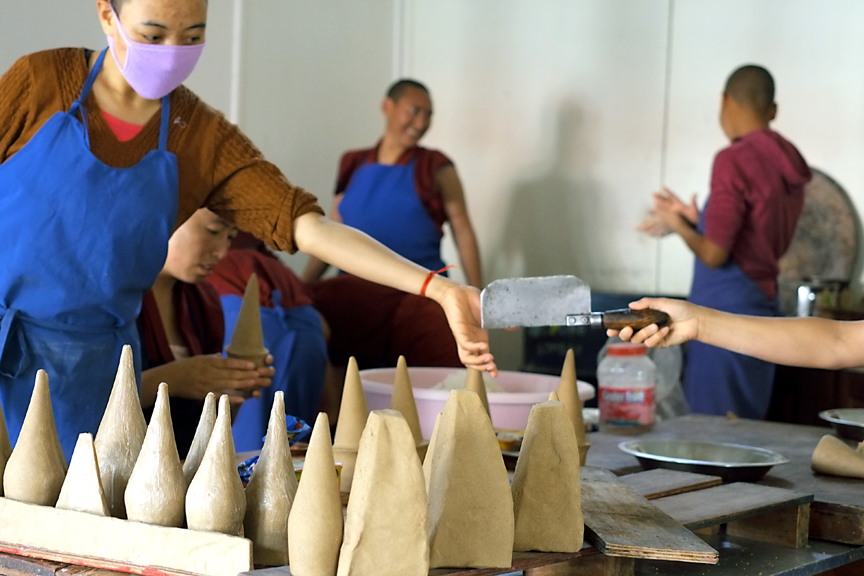Each Wednesday, more than two hundred Tibetan Buddhist nuns rise before dawn and perform the ritual practice of Tara. As do monastics at many nunneries and monasteries of the Tibetan Buddhist tradition, the nuns at Dolma Ling Nunnery and Institute pray to Tara to help end the suffering of all sentient beings and to aid them on their spiritual path.
Starting at 5:30 am and continuing for 90 minutes, the nuns perform a complex ritual focused on Tara, the female Buddha who embodies the wisdom and the compassion of all enlightened beings.
Here is a recording of the Tara puja made by Olivier Adam, a French photographer and supporter of the Tibetan Nuns Project, when he visited Dolma Ling.
The nuns perform the drolchok or Tara Puja on Wednesdays because it is considered an auspicious day for His Holiness the Dalai Lama.
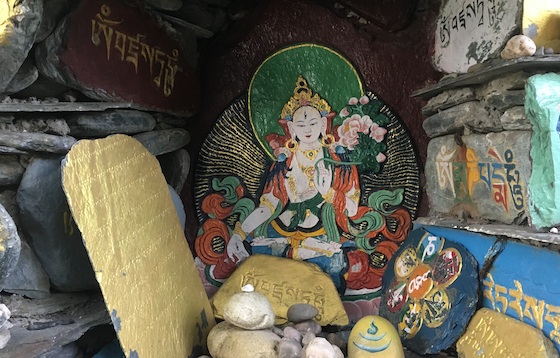
White Tara surrounded by mani stones. Tara is especially revered in Tibetan Buddhism and is known as the “mother of liberation”. Photo courtesy of Heather Wardle
Tara
Tara is believed to be a Bodhisattva of compassion and a protector who relieves physical, emotional, and spiritual suffering. She is known as the “mother of liberation”. Her name in Tibetan is Dolma, “She who Liberates”.
When meditating on Tara, one seeks to develop and enhance inner qualities such as compassion (karuṇa), loving-kindness (maitri), and understanding of emptiness (shunyata).
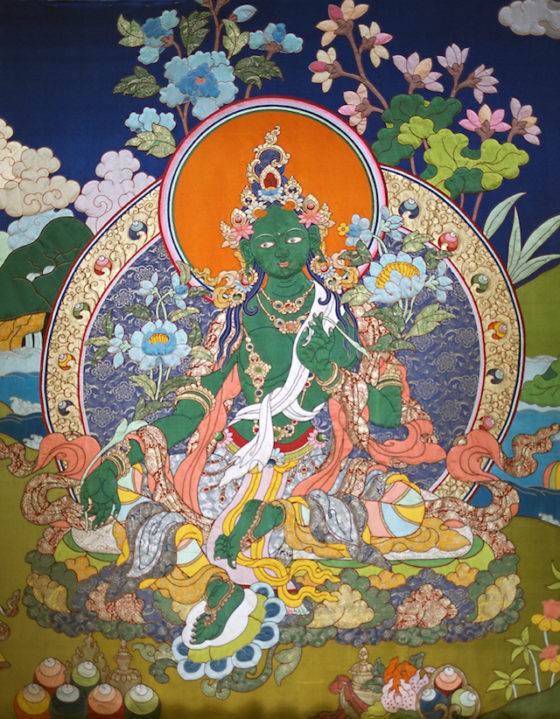
Painting of Green Tara from Dolma Ling Nunnery. Photo courtesy of Brian Harris.
Tara has a great many forms, in which she manifests in various colors. The main are Green Tara, White Tara, and Red Tara.
She is best known in her green form, associated with enlightened activity and abundance, and the best-known prayer to her is the Praises to the Twenty-One Forms of Tara. It is said that she herself revealed it to the great 11th century scholar and teacher, Atisha. He was about to leave on a journey to Tibet to share Buddhist teachings there, and it is said that she appeared to him and said that she would protect him on his journey and he should recite that prayer to protect himself from any difficulties or obstacles. That prayer in the centerpiece of the weekly Tara Ritual, in which it is recited 12 times at various points within the ritual.
Each of the twenty-one emanations of Tara has her own name, special attributes, and a specific mantra with which she is associated, offering protection from various types of fears, harm, and calamities.
The Tara mantra is Om tare tuttare ture svaha.
Early in the coronavirus pandemic, His Holiness the Dalai Lama advised people to chant the Green Tara mantra because it would be “beneficial for effectively containing the spread of the virus”. He has asked people suffering from the disease to chant the Tara mantra, Om tare tuttare ture svaha, to maintain peace of mind and remain free from worries.
Listen to His Holiness the Dalai Lama chanting the Tara Mantra.
,
The Praises to the Twenty-One Forms of Tara
Reciting the Praises to the Twenty-One Forms of Tara with devotion at any time of the day or night protects you from fear and dangers, and fulfils all your wishes, especially wishes on the spiritual path. Meditation on Tara feeds you with endless energy to continue on the path.
Here is an English translation of the Praises to the Twenty-One Forms of Tara.
The Praises to the Twenty-One Forms of Tara
OṂ Jetsunma, prostrations to exalted Tara!
1 Prostrations to Tara, swift and heroic, eyes like lightning, instantaneous,
Sprung from the opening petals of the Lord of the Three Worlds’ tear-born lotus.
2 Prostrations to Her, face as bright as the light of a hundred full moons of autumn,
Blazing with light resplendent of a constellations’ thousand stars.
3 Prostrations to Her, hand adorned with a gold-blue water-born lotus,
Giving, effort, discipline, peace, patience, and concentration Her sphere.
4 Prostrations to Her, crown ornament of the Tathāgatas who has achieved limitless victory
And is served by the Conquerors’ Offspring who have attained all the perfections.
5 Prostrations to Her, who fills the realms of desire, direction, and space with TUTTARA and HŪṂ,
Who pressing down with her foot on the seven worlds can summon all without exception.
6 Prostrations to Her, worshipped by Indra, Agni, Brahmā, Vāyu—by the many worldly Lords;
Before whom the hosts of spirits, corpse-raisers, gandharvas, and yakṣhas give praise.
7 Prostrations to Her who with TRAT and PHAṬ destroys foes’ harmful magic,
Pressing down with right leg bent and left extended, she blazes with raging fire.
8 Prostrations to TURE, terrifying one, destroyer of Māra’s warriors,
Lotus face displaying wrath, she slays all foes without remainder.
9 Prostrations to Her, fingers poised at her heart in the mudra of the Three Precious Jewels,
Her palm is adorned with a universal wheel whose fierce radiance fills all directions.
10 Prostrations to Her, spreading great joy with the rays of light that garland her crown,
Mirthful, laughing, with TUTTARA, she brings the worlds and demons under her sway.
11 Prostrations to Her, able to summon the entire host of earthly protectors;
Fiercely frowning, with the syllable HŪṂ she rescues from every misfortune.
12 Prostrations to Her, crown adorned with a crescent moon, all adornments blazing bright,
From Amitābha within her topknot, light rays always shine forth.
13 Prostrations to Her dwelling in the midst of a garland of flames like the fire at an aeon’s end,
Right leg out, left bent in, she destroys the encircling army of the foes of happiness.
14 Prostrations to Her who smites the earth with her palm and stamps it with her foot;
Displaying wrath, with the syllable HŪṂ she shatters the seven underworlds.
15 Prostrations to Her, blissful, virtuous, peaceful, her sphere is peace, nirvāṇa;
Her mantra graced with OṂ and SV H utterly destroys great wrongdoing.
16 Prostrations to Her who turns the wheel giving joy to those whose foes she destroys;
She liberates with the ten-syllable mantra and knowledge mantra with HŪṂ.
17 Prostrations Swift One, who stamps with her feet, whose seed is the syllable HŪṂ,
She causes Meru, Mandara, Vindhya and the three worlds, too, to shake.
18 Prostrations to Her, who holds in her hand the hare-marked moon shaped like a heavenly lake;
With twice-spoken TARA with the syllable PHEṬ, poisons are completely dispelled.
19 Prostrations to Her, served by the Kings of gods, by gods and kinnaras too;
With the armour of her joyful splendor she dispells conflicts and bad dreams.
20 Prostrations to Her, whose two eyes, the sun and full moon, illumine by their radiance;
With twice spoken HARA and TUTTARA she dispells pestilence and disease.
21 Prostrations to Her with the threefold suchness, perfectly endowed with the power to give peace;
She destroys the hosts of spirits, corpse-raisers and harmers, Oh TURE most sublime!
This is praise of the root mantra and is offered with twenty-one prostrations. (2x)
Tara Mantra OM TA-RE TUT-TA-RE TU-RE SVA-HA
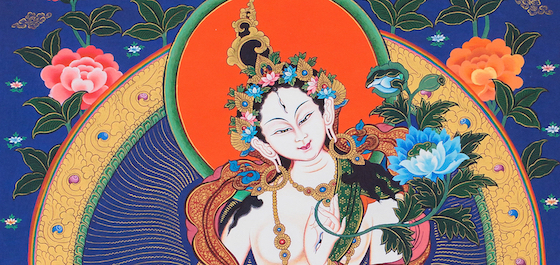
How to request a Puja or Prayers
You don’t have to be a Buddhist to request prayers by the Tibetan nuns. You can ask the Tibetan Buddhist nuns to perform prayers and pujas on your behalf.
People around the world can sponsor pujas or prayers through the Tibetan Nuns Project website. Many people sponsor prayers in honor of loved ones, friends, family members, or even pets who may be suffering from obstacles, ill health, or who have passed away.
There are many different types of prayers or pujas to choose from. Full descriptions of each puja are available here.
When requesting a puja or prayers from the Tibetan Nuns Project, please provide information about who the prayers are to be directed to and for what purpose. All puja funds are sent to the nunneries. All funds are used to purchase puja supplies and to help the nuns and their nunneries.
Tara and the Tibetan Nuns Project Logo
The center of the Tibetan Nuns Project logo is made up of the seed syllables E (pronounced “ay”) and VAM, written in an ancient Sanskrit script, which symbolize wisdom and compassion. These are surrounded by a circle of 21 TAM, the seed syllable of Tara.
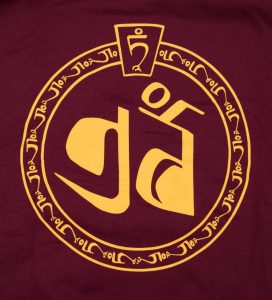
There are 21 because the 21 forms of Tara are one of her most popular manifestations. The nuns have a particular affinity for Tara, the feminine embodiment of compassion and are frequently asked by the Tibetan community to perform Tara rituals on their behalf.

